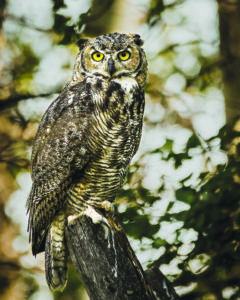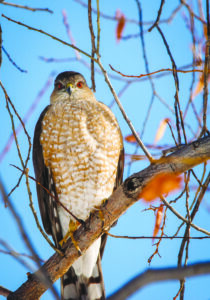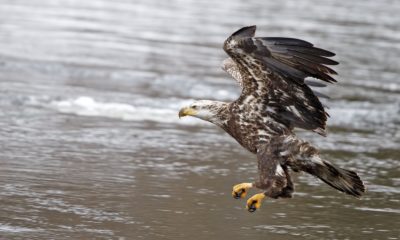Uncategorized
Raptors in the Big Sky
Published
9 years agoon
Posted By
Outlaw Partners
By Jeannie Counce EBS Contributor
Look to the skies this spring and you’re likely to see an incredible display of birds of prey migrating, pairing up and nesting. Raptors, which include eagles, owls, hawks, falcons and vultures, are built to hunt and eat meat.
Nature outfits these large feathered carnivores with keen eyesight, sharp beaks, and gripping talons to make them highly efficient predators – though vultures are the exception as they scavenge all their food.
Amazing species-specific adaptations, including the osprey’s moveable talon that allows it to aerodynamically fly while holding a fish, or the owl’s flight feathers that virtually eliminate any audible warning of its approach, make raptors especially interesting to observe.
Since 1988, Montana Raptor Conservation Center has been rehabilitating injured birds of prey from across the state and educating the community on the importance of raptors in the environment. As the hillsides turn green and the rivers begin to flood, the experts at MRCC suggest you watch for seasonal raptor behaviors.The largest and perhaps most revered of the raptors, eagles are plentiful in southwest Montana now. Attracted by a burgeoning food supply, migrants are arriving from the south and mixing with local residents.
“These birds are beginning to pair up now,” said MRCC Director Becky Kean. “They are monogamous and tend to use the same nest year after year to raise their young. The male usually arrives at the nest site a week or so before the female to make repairs.”
Bald eagles have a 7-foot wingspan and golden eagles a 9-foot wingspan, and both feast on ground squirrels and other rodents, although they’re also opportunistic scavengers.
“We see many eagles with lead poisoning this time of year because they’ve been surviving on gut piles left behind by hunters all winter,” says Kean, adding that MRCC is currently detoxing two golden eagles in hopes that they can be released in time to find their mates.
“As sea eagles, bald eagles take advantage of melting rivers and lakes to hunt for fish,” Kean said. “Look for their enormous nests, which can be five to nine feet across, in trees along waterways.”
Hawks also migrate and pair up, but lag behind by a few weeks,
according to MRCC Assistant Director Jordan Spyke. “They are known as ‘the farmer’s friend,’ because of their appetite for nuisance animals, such as mice, voles and rats, which are all beginning to be active right now,” he said.Osprey, which make their stick and sod nests atop telephone poles, channel markers, and other vertical structures near water, dine almost exclusively on fish, Spyke adds.
“Springtime brings red-tailed hawks from the southwest and Mexico as well as Swainson’s hawks and osprey from South America, while rough-legged hawks who wintered here prepare to fly back to their breeding grounds on the tundra,” he says, noting that “roughies” are one of two species of hawk with feathers on their legs and feet to protect against the cold – the other is Ferruginous hawks.
“Look for hawks hovering on windy days,” Spyke said. “They face into the wind so they don’t have to use energy flapping while searching for prey.”
Owls are typically “on the nest” this time of year, according to Kean. “Their jobs are made easier by the fact that they use old nests abandoned by crows, hawks, and magpies,” she said. “By mid-March and early April, females are spending most of their time incubating eggs and males are doing the majority of the hunting,” she said.
“Vultures are harbingers of spring,” adds Spyke. “They are not equipped for our winter – think bald heads – so when you see a vulture, you know it’s warming up.”
This time of year MRCC sees an uptick in injuries because of the increased drive to hunt and feed young, according to Kean. “Raptors will crash into trees and even cars,” she said. “Often they’ll try to make an easy meal of road kill – if they eat too much, they can’t get airborne and out of the way quickly enough.”
If you see an injured raptor, report it to Montana Raptor Conservation Center (406) 585-1211 as soon as possible.
Jeannie Counce is a Bozeman-based writer and editor. She is the communications volunteer for the Montana Raptor Conservation Center, which has a mission to improve the welfare of raptors across Montana through rehabilitation of injured birds, community education, and partnerships for raptor conservation and research.
The Outlaw Partners is a creative marketing, media and events company based in Big Sky, Montana.


Upcoming Events
november, 2024
Event Type :
All
All
Arts
Education
Music
Other
Sports
Event Details
Spanish Classes with World Language InitiativeThese unique, no cost Spanish classes are made possible by the contribution of Yellowstone Club
more
Event Details
Spanish Classes with World Language InitiativeThese unique, no cost Spanish classes are made possible by the contribution of Yellowstone Club Community Foundation (YCCF) and Moonlight Community Foundation (MCF). This class will focus on building a lifelong affinity for world languages and cultures through dynamic and immersive Communicative Language teaching models.
Beginner Class – Mondays and Wednesdays from 5:30-6:30 pm
Intermediate Class – Mondays and Wednesdays from 6:45- 7:45 pm
- Classes begin Oct.7, 2024 and run for 6 weeks
- Class size is limited to 12 students
- Classes are held in Big Sky at the Big Sky Medical Center in the Community Room
For more information or to register follow the link below or at info@wlimt.org.
Time
October 21 (Monday) 5:30 pm - November 27 (Wednesday) 7:45 pm
Location
Big Sky Medical Center - Community Room (2nd Floor)
Big Sky Medical Center - Community Room (2nd Floor)
Event Details
Spanish Classes with World Language InitiativeThese unique, no cost Spanish classes are made possible by the contribution of Yellowstone Club
more
Event Details
Spanish Classes with World Language InitiativeThese unique, no cost Spanish classes are made possible by the contribution of Yellowstone Club Community Foundation (YCCF) and Moonlight Community Foundation (MCF). This class will focus on building a lifelong affinity for world languages and cultures through dynamic and immersive Communicative Language teaching models.
Beginner Class – Mondays and Wednesdays from 5:30-6:30 pm
Intermediate Class – Mondays and Wednesdays from 6:45- 7:45 pm
- Classes begin Oct.7, 2024 and run for 6 weeks
- Class size is limited to 12 students
- Classes are held in Big Sky at the Big Sky Medical Center in the Community Room
For more information or to register follow the link below or at info@wlimt.org.
Time
October 28 (Monday) 5:30 pm - December 4 (Wednesday) 7:45 pm
Location
Big Sky Medical Center - Community Room (2nd Floor)
Big Sky Medical Center - Community Room (2nd Floor)
Event Details
Spanish Classes with World Language InitiativeThese unique, no cost Spanish classes are made possible by the contribution of Yellowstone Club
more
Event Details
Spanish Classes with World Language InitiativeThese unique, no cost Spanish classes are made possible by the contribution of Yellowstone Club Community Foundation (YCCF) and Moonlight Community Foundation (MCF). This class will focus on building a lifelong affinity for world languages and cultures through dynamic and immersive Communicative Language teaching models.
Beginner Class – Mondays and Wednesdays from 5:30-6:30 pm
Intermediate Class – Mondays and Wednesdays from 6:45- 7:45 pm
- Classes begin Oct.7, 2024 and run for 6 weeks
- Class size is limited to 12 students
- Classes are held in Big Sky at the Big Sky Medical Center in the Community Room
For more information or to register follow the link below or at info@wlimt.org.
Time
November 4 (Monday) 5:30 pm - December 11 (Wednesday) 7:45 pm
Location
Big Sky Medical Center - Community Room (2nd Floor)
Big Sky Medical Center - Community Room (2nd Floor)











